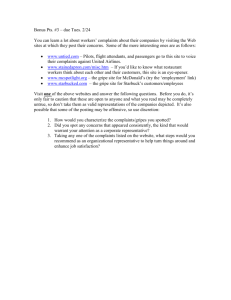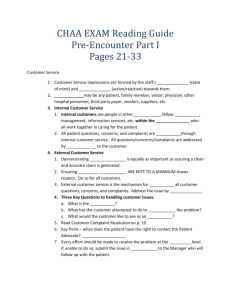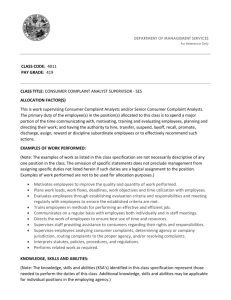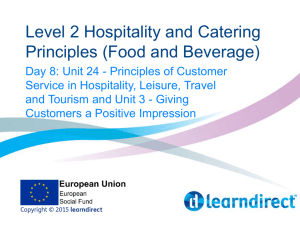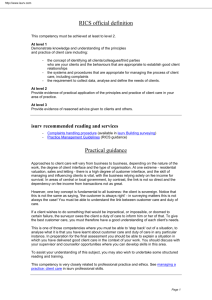Five Star Evaluations
advertisement
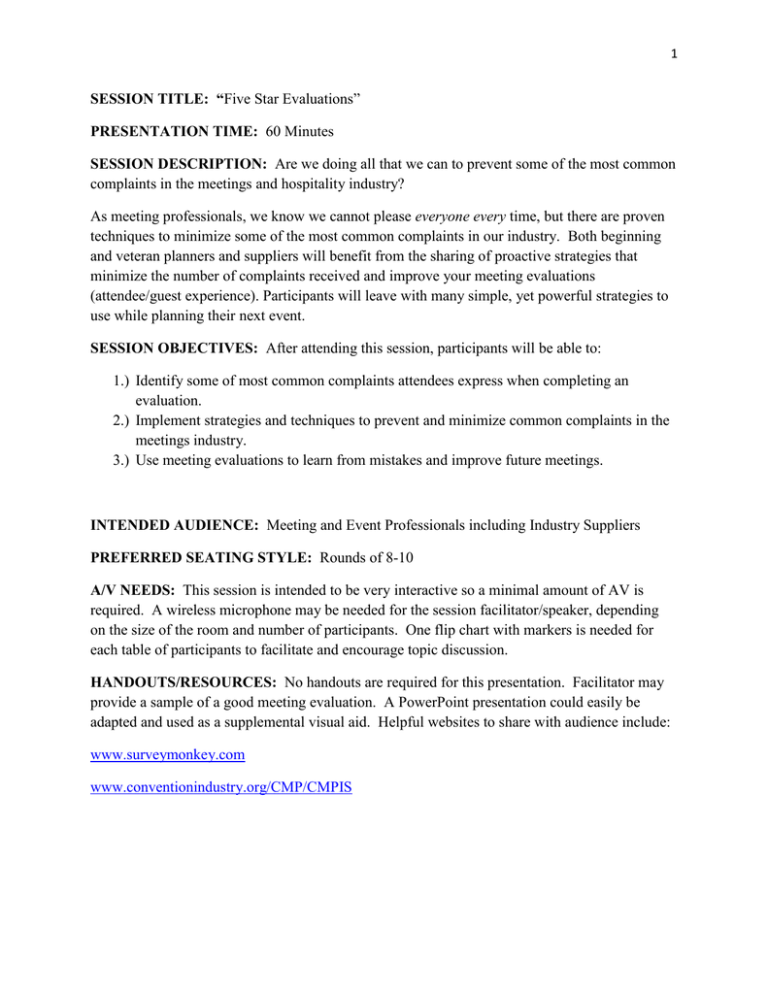
1 SESSION TITLE: “Five Star Evaluations” PRESENTATION TIME: 60 Minutes SESSION DESCRIPTION: Are we doing all that we can to prevent some of the most common complaints in the meetings and hospitality industry? As meeting professionals, we know we cannot please everyone every time, but there are proven techniques to minimize some of the most common complaints in our industry. Both beginning and veteran planners and suppliers will benefit from the sharing of proactive strategies that minimize the number of complaints received and improve your meeting evaluations (attendee/guest experience). Participants will leave with many simple, yet powerful strategies to use while planning their next event. SESSION OBJECTIVES: After attending this session, participants will be able to: 1.) Identify some of most common complaints attendees express when completing an evaluation. 2.) Implement strategies and techniques to prevent and minimize common complaints in the meetings industry. 3.) Use meeting evaluations to learn from mistakes and improve future meetings. INTENDED AUDIENCE: Meeting and Event Professionals including Industry Suppliers PREFERRED SEATING STYLE: Rounds of 8-10 A/V NEEDS: This session is intended to be very interactive so a minimal amount of AV is required. A wireless microphone may be needed for the session facilitator/speaker, depending on the size of the room and number of participants. One flip chart with markers is needed for each table of participants to facilitate and encourage topic discussion. HANDOUTS/RESOURCES: No handouts are required for this presentation. Facilitator may provide a sample of a good meeting evaluation. A PowerPoint presentation could easily be adapted and used as a supplemental visual aid. Helpful websites to share with audience include: www.surveymonkey.com www.conventionindustry.org/CMP/CMPIS 2 PRESENTATION OUTLINE INTRODUCTION: Whether you work as a planner or supplier in the meetings and events industry, one thing I think we all have to deal with at some time are…..complaints! When you have large groups of people, one thing is for sure….You will never please every person every time! 5% of attendees who will complain no matter what! Don’t worry about them! (The larger the group, the higher the probability there will be complaints) Today, we’re going to discuss the complaints we hear most often in our industry and then we’re going to brainstorm possible solutions so may prevent those typical complaints. BODY: Meeting Goals & Objectives (first step) What is the first step when planning a meeting? Defining goals and objectives! Complaints about common issues can take away from meeting your stated goals and objectives. Meeting Evaluation (last step) People familiar with continuous improvement principles know that the last step in any activity should be an evaluation of performance. Meetings are no different. We need to learn from our mistakes and don’t make the same mistake twice. We need to capture the opinions and apply lessons learned to future meetings. Evaluation – Definition A systematic process to determine the value of an activity. What are you trying to learn during an evaluation? Some of the basic questions the evaluation should address: Was the meeting well planned? Did we achieve the planned objectives? Were the right people involved in the meeting? Evaluation Tools 5 point Likert scale. Strongly disagree, Disagree, Neutral, Agree, Strongly agree. Survey Monkey – Easy to use web based survey tool. Free up to 10 questions, 100 respondents. Monthly premiums for more advanced features. What are other survey tools? Does anyone still use paper evaluations? Google docs Informal comments overheard or mentioned ruing the event. 3 Round Table Discussion/Brainstorming Activity: This activity requires designating one person per table to serve as a scribe and one person per table to report out to full group. Ideally, it is good to appoint one person at each table to facilitate the discussion to get as much participation as possible – possibly assign a board member to each table to serve in that role. Each table will address the following questions: 1.) What are some of the most common complaints attendees express when completing an evaluation? (allow 10 minutes for discussion and list creation plus 5 minutes to report out) 2.) What are some proactive steps we can take to prevent or minimize these common complaints? (allow 15 minutes for brainstorming strategies and sharing best practices plus 5 minutes to report out) COMMON COMPLAINTS: Participants should identify common complaints, however, here are a few ideas/conversation starters if group needs a kick-start. Parking (cost of parking, in/out privileges, method of payment, proximity to main entrance to building, availability, safety for visitors and vehicles?) Location of Meeting Site Competing Events in Same Facility Slow Service Room Temperature Clean Restrooms POSSIBLE SOLUTIONS: Again, the idea is for participants to discuss and come up with potential solutions and measures to prevent complaints. A few ideas/conversation starters include: Location - Know your audience and select your venue accordingly. Try to evaluate a venue through the perspective of attendees/guests. Parking - Include parking evaluation on site visit – note related issues. Communicate parking information and maps in meeting announcements and advance communications. Competition - Ask venue coordinator what other events are occurring at the same time? Is there a way to separate the events? Good question to ask during site visit. 4 Slow Service - Understand the service standards of the facility? How many servers/table? 1:2 ideal Room Temperature - Recommended Dress Code: As meeting rooms always seem to be “too hot” or “too cold” and personal comfort levels vary widely, we suggest bringing a jacket or sweater. Digital thermostats help. Set 2-3 degrees cooler than desired temperature. Begin to cool room at least one hour in advance. Learn how to adjust temperature. Don’t react to 1 or 2 complaints. Clean Restrooms – Prevention is key. Give janitorial staff the meeting agenda so they can service the restrooms before breaks. MORE PREVENTION STRATEGIES: Recruit volunteers to assist on-site with frequent questions, directions etc. Don’t go it alone! Partner with facility staff to find good solutions to issues in advance. Communication is key! CONCLUSION: Remember, that complaints are a fact of life and will always be part of the process. We cannot eliminate all complaints but there are a lot of strategies we can use to prevent and minimize the complaints. It’s important to listen to the feedback of attendees, view complaints as opportunities for improvement (OFI), identify reason for success/failure and take action so you may improve your meetings or events in the future! REVIEW PRESENTATION OBJECTIVES: So….let’s review today’s session objectives…. Did we learn how to: 1.) Identify some of most common complaints attendees express when completing an evaluation. 2.) Implement strategies and techniques to prevent and minimize common complaints in the meetings industry. 3.) Use meeting evaluations to learn from mistakes and improve future meetings. QUESTIONS AND ANSWERS: Be sure to allow sufficient time for questions and answers! (Allow at least 5 minutes at end of presentation for Q & A) 5 PRESENTATION INFORMATION: This presentation was originally developed by Shari Goad, CMP for the Wild West Chapter of SGMP to be presented October 10, 2013 during monthly chapter meeting. Shari may be reached at 405.743.5116 or sgoad@okcareertech.org
